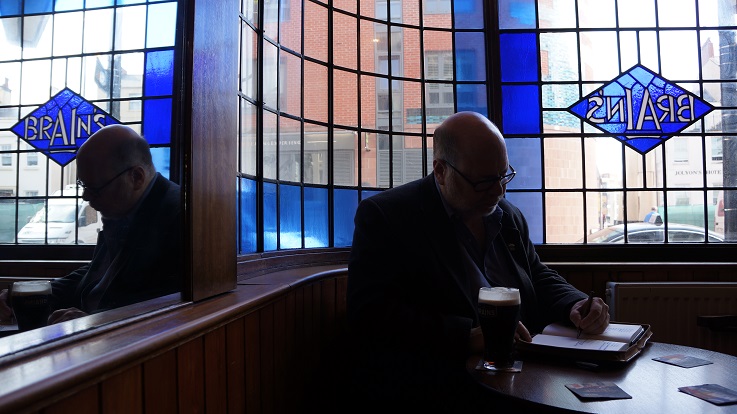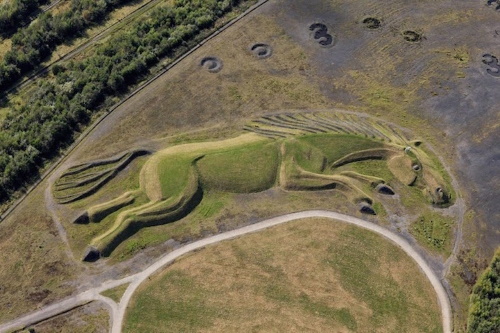 |
94. Three Sallies
New York City had everything I could want. Cardiff has everything I need.
Living in Cardiff, I frequently heard about The Valleys that all flow into Cardiff. Not long ago, it was the coal industry that flowed out of The Valleys and into the famous docks of Cardiff, and from that port they floated to the rest of the world. The villages of The Valleys grew in population as they grew in industry, but coal is king no more. The Valleys declined in wealth and now it was the youth born there that flowed out of The Valleys in search of more exciting or rewarding lives. Much of the culture of the Welsh poured out of The Valleys and some of my newest friends, those I have acquired since residing in Cardiff, were born in The Valleys.
It was two years ago when I first proposed that Stephen should give me a tour of his valley home. Since Stephen did not drive, I offered to rent a car and take him. I wanted to understand better what it was to be born a Welshman. I wanted a clearer picture of his childhood surroundings. The only image I carried of The Valleys was John Ford’s 1941 film, How Green Was My Valley. Personal tragedies postponed the adventure for both of us until late this summer, by which time the expedition’s goals were expanded.
Stephen was from the Rhondda Valley, of which there are two. Stephen was from the larger of the two, Rhondda Fawr. When we mentioned our plans to our mutual friend Brian, he wanted to join us, having never been to the Rhondda Valley. Since Brian could drive and Brian had a car, I thought why not? The plans grew as it was discovered Stephen had never been to Brian’s valley, the Rhymney Valley. It was decided we would make two trips and could spend a day in each.
It grew again when Ken and Kevin learned of our plans. This was the entire group of gentlemen with whom I meet almost every Friday night for cocktails and conversation. A third day was added so Ken could show us his childhood home in Swansea, not exactly a valley, but fair is fair and we were curious. Alas, I could not lead a trip to where I was born in The Bronx, nor could Kevin who was born in Tenerife. Since there were now five of us, we had to rent a larger car than Brian’s tiny Renault.
I thought they were mountains. The two valley trips introduced me to slag heaps, the spoil tips of the mining industry. In Brian’s tour of the Rhymney Valley, we drove up the Penallta slag heap to see the sculpture of a prancing horse created by the Welsh artist Mick Petts. We had all seen photographs of it taken from the air, which is probably the best way of viewing this tremendous raised earthwork over 650 feet long. It is the largest such figure in the United Kingdom. The Uffington White Horse is a mere 360 feet long. Yet the horse represented is just a small pit pony, the kind used for hauling tubs of coal along mining tracks. The locals have named the sculpture Sultan, after a beloved pit pony that worked in the Penallta colliery. We climbed about its muzzle trying to identify its features.

Slag heaps are carefully monitored and managed now, but it wasn’t the case in 1966 when on the 21st October the Aberfan disaster happened. A slag heap avalanche engulfed the Pantglas Junior School killing 109 children and 5 teachers who were in the school. In all, 116 children and 28 adults died that tragic morning. Ken was there among the young volunteers who came from Swansea to help dig out the victims.
Brian’s father owned and operated a shop in the Rhymney Valley that sold women’s clothes. The shop is still there, owned by someone else, selling something else. He took us to the place from which he could see the flashes of light beyond the valley, a witness to the Cardiff Blitz. He left the valley a young man, forgoing a career in a bank to join the Merchant Navy as a purser, thus seeing the world.
On the next day, we ventured into the Rhondda Valley, Stephen’s valley. His mother still lives there. At one point, when we paused for a meal, the people at the next table were relatives and acquaintances of his.
We visited a mining museum and there had tea or coffee. We then drove to the far end of a side valley until we could travel no further, reaching the entrances to the Cambrian Colliery mineshafts. They were sealed, almost hidden among the trees that have grown on the hillside since, making it beautiful. Here also an area has been fashioned with bits of mine equipment and a decorative wall to serve as a reminder of the harsh industry that formerly sprawled across this region as an infected wound, black and festering. What remained was a memorial for the 1965 mine explosion that killed thirty-one miners, Stephen’s uncle among them.
Before we left the Rhondda Valley, Stephen directed Brian to drive us high up a mountainside with a panoramic view. Best of all, there, high above the valley, were scattered stones that offered some semblance of the foundations of an Iron Age encampment that once occupied the place.
It was autumn before we would make our third and final sally, this time to Ken’s Swansea. And this time we could all fit into Brian’s tiny Renault. Kevin, being younger, couldn’t join us. He still worked for a living while the rest of us were retired.
Ken’s successful career and expanding family meant a series of homes, each an improvement on the last. But the first one, the one into which he was born, that house was missing. The lot was deserted and grown over with trees and shrubs behind a low stone wall.
Wherever you go there are churches. Ken took us to a portion of the Wales Coast Path, a trail of over 870 miles that outlines nearly the entire coastline of Wales, except for 20% where you are out of sight of the coast because some landowners would not allow it to cross their property. We walked 870 feet of it to reach Saint Illtyd’s Church on Oxwich Bay. It is tucked into the wooded hillside and not seen until you are close. The sandy beach of the bay gave way to rocks and the small church was not very far up the hill. It was surrounded by graves that appeared thrown about by a restless ground. For that it felt ancient, but we found no graves older than the 18th century and at least one grave as recent as 2017.
A padlock kept us from entering the church. A sign explained that the building was 13th century, the bell tower 14th century. But the site has had a “Christian building” on it since the 6th century, perhaps a monk’s cell.
What we didn’t know at the time is we could have gotten the key from the Rector. Inside we would have found the Sutton Stone font, alleged to have been brought to the church by the saint himself.
As hard as I tried to observe as much as I could, I missed wonderful features I read about later after returning home. I had not noticed the haunted well at the top of the graveyard, although it had dried up and was no longer a fit place for a Ceffyl Dŵr [mythical water horse]. I had not seen the grave of the British sailor “known unto God” whose body washed onto Oxwich Bay during the Great War.
It was getting late and we left the church to return to the car. I pointed to the long crescent beach of Oxwich Bay and told Ken I would come back and install a plaque there. He asked why. It was the spot he identified earlier as where he lost his virginity when he was eighteen, parked on the beach, in the backseat of his red Ford Consol 2000E, the four-door, an automatic, with black vinyl roof and beige cloth seats.
Last Friday, we five met as usual for cocktails and conversations, and spoke about our three sallies. My new, dear friends taught me a new Welsh word: hiraeth.
![]()
Mr Bentzman will continue to report here regularly about
the events and concerns of his life. If you've any
comments or suggestions, he would be pleased to hear from you.
You can find his
several books at www.Bentzman.com.
Enshrined
Inside Me, his second collection of
essays, is now available to purchase.
